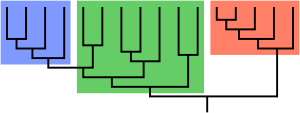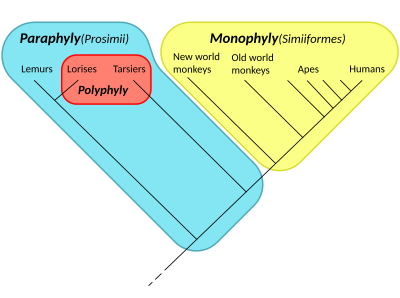Paraphyly

Paraphyly is a
The terms are commonly used in
The term received currency during the debates of the 1960s and 1970s accompanying the rise of cladistics, having been coined by zoologist Willi Hennig to apply to well-known taxa like Reptilia (reptiles), which is paraphyletic with respect to birds. Reptilia contains the last common ancestor of reptiles and all descendants of that ancestor except for birds. Other commonly recognized paraphyletic groups include fish, monkeys, and lizards.[1][page needed]
Etymology
The term paraphyly, or paraphyletic, derives from the two Ancient Greek words παρά (pará), meaning "beside, near", and φῦλον (phûlon), meaning "genus, species",[2][3] and refers to the situation in which one or several monophyletic subgroups of organisms (e.g., genera, species) are left apart from all other descendants of a unique common ancestor.
Conversely, the term monophyly, or monophyletic, builds on the Ancient Greek prefix μόνος (mónos), meaning "alone, only, unique",[2][3] and refers to the fact that a monophyletic group includes organisms consisting of all the descendants of a unique common ancestor.
By comparison, the term polyphyly, or polyphyletic, uses the Ancient Greek prefix πολύς (polús), meaning "many, a lot of",[2][3] and refers to the fact that a polyphyletic group includes organisms arising from multiple ancestral sources.
Phylogenetics

In cladistics
Groups that include all the descendants of a common ancestor are said to be
A group whose identifying features evolved
These terms were developed during the debates of the 1960s and 1970s accompanying the rise of cladistics.
Paraphyletic groupings are considered problematic by many taxonomists, as it is not possible to talk precisely about their phylogenetic relationships, their characteristic traits and literal extinction.[6][7] Related terms are stem group, chronospecies, budding cladogenesis, anagenesis, or 'grade' groupings. Paraphyletic groups are often relics from outdated hypotheses of phylogenic relationships from before the rise of cladistics.[8]
Examples
The
Among plants,
Among animals, several familiar groups are not, in fact, clades. The order
Osteichthyes, bony fish, are paraphyletic when circumscribed to include only Actinopterygii (ray-finned fish) and Sarcopterygii (lungfish, etc.), and to exclude tetrapods; more recently, Osteichthyes is treated as a clade, including the tetrapods.[14][15]
The "
One of the goals of modern taxonomy over the past fifty years has been to eliminate paraphyletic "groups", such as the examples given here, from formal classifications.[19][20]
Paraphyly in species
Species have a special status in systematics as being an observable feature of nature itself and as the basic unit of classification.[21] Some articulations of the phylogenetic species concept require species to be monophyletic, but paraphyletic species are common in nature, to the extent that they do not have a single common ancestor. Indeed, for sexually reproducing taxa, no species has a "single common ancestor" organism. Paraphyly is common in speciation, whereby a mother species (a paraspecies) gives rise to a daughter species without itself becoming extinct.[22] Research indicates as many as 20 percent of all animal species and between 20 and 50 percent of plant species are paraphyletic.[23][24] Accounting for these facts, some taxonomists argue that paraphyly is a trait of nature that should be acknowledged at higher taxonomic levels.[25][26]
Cladists advocate a phylogenetic species concept
Uses for paraphyletic groups
When the appearance of significant traits has led a subclade on an evolutionary path very divergent from that of a more inclusive clade, it often makes sense to study the paraphyletic group that remains without considering the larger clade. For example, the
Also, some systematists recognize paraphyletic groups as being involved in evolutionary transitions, the development of the first tetrapods from their ancestors for example. Any name given to these hypothetical ancestors to distinguish them from tetrapods—"fish", for example—necessarily picks out a paraphyletic group, because the descendant tetrapods are not included.[30] Other systematists consider reification of paraphyletic groups to obscure inferred patterns of evolutionary history.[31]
The term "evolutionary grade" is sometimes used for paraphyletic groups.[32] Moreover, the concepts of monophyly, paraphyly, and polyphyly have been used in deducing key genes for barcoding of diverse group of species.[33]
Independently evolved traits
Current phylogenetic hypotheses of tetrapod relationships imply that
Groupings based on independently-developed traits such as these examples of viviparity represent examples of polyphyly, not paraphyly.[citation needed]
Not paraphyly
- Amphibious fish are polyphyletic, not paraphyletic. Although they appear similar, several different groups of amphibious fishes such as mudskippers and lungfishes evolved independently in a process of convergent evolution in distant relatives faced with similar ecological circumstances.[34]
- Flightless birds are polyphyletic because they independently (in parallel) lost the ability to fly.[35]
- Animals with a dorsal fin are not paraphyletic, even though their last common ancestor may have had such a fin, because the Mesozoic ancestors of porpoises did not have such a fin, whereas pre-Mesozoic fish did have one.
- Quadrupedal archosaurs are not a paraphyletic group. Bipedal dinosaurs like Eoraptor, ancestral to quadrupedal ones, were descendants of the last common ancestor of quadrupedal dinosaurs and other quadrupedal archosaurs like the crocodilians.
Non-exhaustive list of paraphyletic groups
The following list recapitulates a number of paraphyletic groups proposed in the literature, and provides the corresponding monophyletic taxa.
Linguistics
The concept of paraphyly has also been applied to historical linguistics, where the methods of cladistics have found some utility in comparing languages. For instance, the Formosan languages form a paraphyletic group of the Austronesian languages because they consist of the nine branches of the Austronesian family that are not Malayo-Polynesian and are restricted to the island of Taiwan.[67]
See also
Explanatory notes
- ^ The history of flowering plant classification can be found under History of the classification of flowering plants.
References
- ^ Romer, A. S. (1970) [1949]. The Vertebrate Body (4th ed.). W.B. Saunders.
- ^ OCLC 461974285.
- ^ a b c Bailly, Anatole. "Greek-french dictionary online". www.tabularium.be. Retrieved 8 March 2018.
- ISBN 978-0-470-05723-0.
- ^ Williams, D. M. and Ebach. M. C. 2020. Cladistics: a guide to biological classification. Cambridge University Press.
- ISBN 978-94-007-2335-1.
- PMID 29380889.
- S2CID 55540349.
- PMID 15944457.
- ^ Stackebrabdt, E.; Tindell, B.; Ludwig, W.; Goodfellow, M. (1999). "Prokaryotic Diversity and Systematics". In Lengeler, Joseph W.; Drews, Gerhart; Schlegel, Hans Günter (eds.). Biology of the prokaryotes. Stuttgart: Georg Thieme Verlag. p. 679.
- ^ a b Simpson 2006, pp. 139–140. "It is now thought that the possession of two cotyledons is an ancestral feature for the taxa of the flowering plants and not an apomorphy for any group within. The 'dicots' ... are paraphyletic ...."
- ^ .
- ^ Romer, A. S. & Parsons, T. S. (1985): The Vertebrate Body. (6th ed.) Saunders, Philadelphia.
- ^ .
Symphyta and Apocrita have long been considered as suborders of Hymenoptera but since recognition of the paraphyletic nature of the Symphyta (Köningsmann 1977, Rasnitsyn 1988) and the advent of cladistic methods the subordinal classification should be avoided. Likewise the woodwasps are thought to be non-monophyletic, forming a grade that is ancestral relative to Apocrita and Orussidae. The traditional hymenopteran classification is faulty, by cladistic criteria, in the same way as pre-cladistic vertebrate classifications in which groups sharing plesiomorphic characterswere recognized as natural, e.g., fishes were once grouped together as 'Pisces', which excluded tetrapods.
- PMID 23653398. Archived from the originalon 13 October 2013.
- ^ S2CID 230835.
- ^ PMID 21315832.
- ^ PMID 22049065.
- ^ Schuh, Randall T. "The Linnaean system and its 250-year persistence." The Botanical Review 69, no. 1 (2003): 59.
- S2CID 224927279.
- S2CID 40799805.
- ISBN 978-0-520-26868-5. Retrieved 28 June 2011 – via Google Books.
- PMID 24583289.
- . Retrieved 22 January 2015.
- ^ Zander, Richard (2013). Framework for Post-Phylogenetic Systematics. St. Louis: Zetetic Publications, Amazon CreateSpace.
- ^ Aubert, D. (2015). "A formal analysis of phylogenetic terminology: Towards a reconsideration of the current paradigm in systematics". Phytoneuron. 66: 1–54.
- S2CID 84095773.
- ISBN 978-1-5017-5277-3.
- S2CID 83900580.
- ^ Kazlev, M.A. & White, T. "Amphibians, Systematics, and Cladistics". Palaeos website. Retrieved 16 August 2012.
- .
- ISBN 978-0-618-00583-3.
- S2CID 195828782.
- .
- PMID 18765814.
- ISBN 978-0-03-075453-1.
- ISSN 1439-6092.
- ISBN 978-0-486-15135-9.
- OCLC 156823511.
- S2CID 29130876.
- PMID 12220977.
- ^ "Gnathifera - Richard C. Brusca" (PDF).
- ^ Tree of life web project – Chordates Archived 24 February 2007 at the Wayback Machine.
- ISBN 0-19-860426-2.
- PMID 25803280.
- S2CID 83592270.
- ISBN 978-0-632-05637-8.
- ISBN 0-8160-1194-X.
- OCLC 4656321698.
- S2CID 10869981.
- ^ Parasitic Hymenoptera (Parasitica). RL Zuparko, Encyclopedia of Entomology, 2004
- S2CID 85975284.
- PMID 19273476.
- ^ Scoble, M.J. (1995). The Lepidoptera: form, function and diversity. Oxford: Oxford University Press. p. 404.
- PMID 24475157.
- OCLC 752875516.
- PMID 23240028.
- .
- PMID 26465609.
- S2CID 4397099.
- S2CID 22823313.
- OCLC 752875516.
- ^ Shimek, Ronald (January 2006). "Nano-Animals, Part I: Rotifers". Reefkeeping.com. Retrieved 27 July 2008.
- ^ AronRa (16 January 2010). Turns out we DID come from monkeys!. Retrieved 12 November 2018.
- ^ "Early Primate Evolution: The First Primates". anthro.palomar.edu. Archived from the original on 10 January 2018. Retrieved 12 August 2017.
- ISBN 0-8018-8221-4., p. 699.
- ^ Greenhill, Simon J. and Russell D. Gray. (2009.) "Austronesian Language and Phylogenies: Myths and Misconceptions About Bayesian Computational Methods," in Austronesian Historical Linguistics and Culture History: a Festschrift for Robert Blust, edited by Alexander Adelaar and Andrew Pawley. Canberra: Pacific Linguistics, Research School of Pacific and Asian Studies, The Australian National University.
Bibliography
- Simpson, Michael George (2006). Plant systematics. Burlington; San Diego; London: ISBN 978-0-12-644460-5.
- Paraphyletic groups as natural units of biological classification
